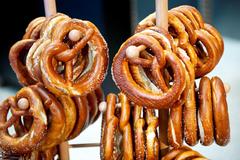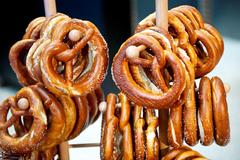
If you’ve ever been to a German bakery, you might have noticed the fresh-baked pretzels every morning behind the glass. Pretzels have long been a part of German food culture – but they have also made their way to the United States.
 There are several unconfirmed stories about the invention of the pretzel, but the earliest recorded evidence of pretzels is their appearance in the crest of German bakers’ guilds in the year 1111. A pretzel was also depicted in an 1185 painting of a banquet for the Persian King Ahaseurus, which was published in the Hortus Deliciarum, a medieval manuscript that was compiled in Alsace (which at that time was claimed by the German Empire). A prayer book from 1140 also shows St. Bartholomew surrounded by pretzels. Later images show pretzels hung around childrens’ necks on New Year’s Day for good luck, on Christmas trees in Austria and as part of Easter egg hunts in Germany. During the 16th century, pretzels were consumed on Good Friday, and some Catholics considered them an important part of Lent.
There are several unconfirmed stories about the invention of the pretzel, but the earliest recorded evidence of pretzels is their appearance in the crest of German bakers’ guilds in the year 1111. A pretzel was also depicted in an 1185 painting of a banquet for the Persian King Ahaseurus, which was published in the Hortus Deliciarum, a medieval manuscript that was compiled in Alsace (which at that time was claimed by the German Empire). A prayer book from 1140 also shows St. Bartholomew surrounded by pretzels. Later images show pretzels hung around childrens’ necks on New Year’s Day for good luck, on Christmas trees in Austria and as part of Easter egg hunts in Germany. During the 16th century, pretzels were consumed on Good Friday, and some Catholics considered them an important part of Lent.
Pretzels were deeply integrated in both religion and German culture. As a result, German immigrants brought pretzels with them when they came to the US in the 1700s, and pretzels quickly became a staple food of the Pennsylvania Dutch. In 1861, a man named Julius Sturgis founded the first pretzel bakery in the US, calling it the Sturgis Pretzel House. The bakery, which is located in Lititz, Pennsylvania, continues to produce pretzels and is also a tourist attraction, run by Sturgis’ descendents. To this day, Pennsylvania remains a hot spot for pretzel production, producing about 80 percent of all pretzels in the US.
In Germany, pretzels also grew in popularity and can now be found at food carts, fairs and festivals and childrens’ lunch boxes. From Germany’s Oktoberfest to the pretzel stand at a US shopping mall, this medieval European delicacy has made its way around the world.
By Nicole Glass, Editor of The Week in Germany for the German Missions in the United States